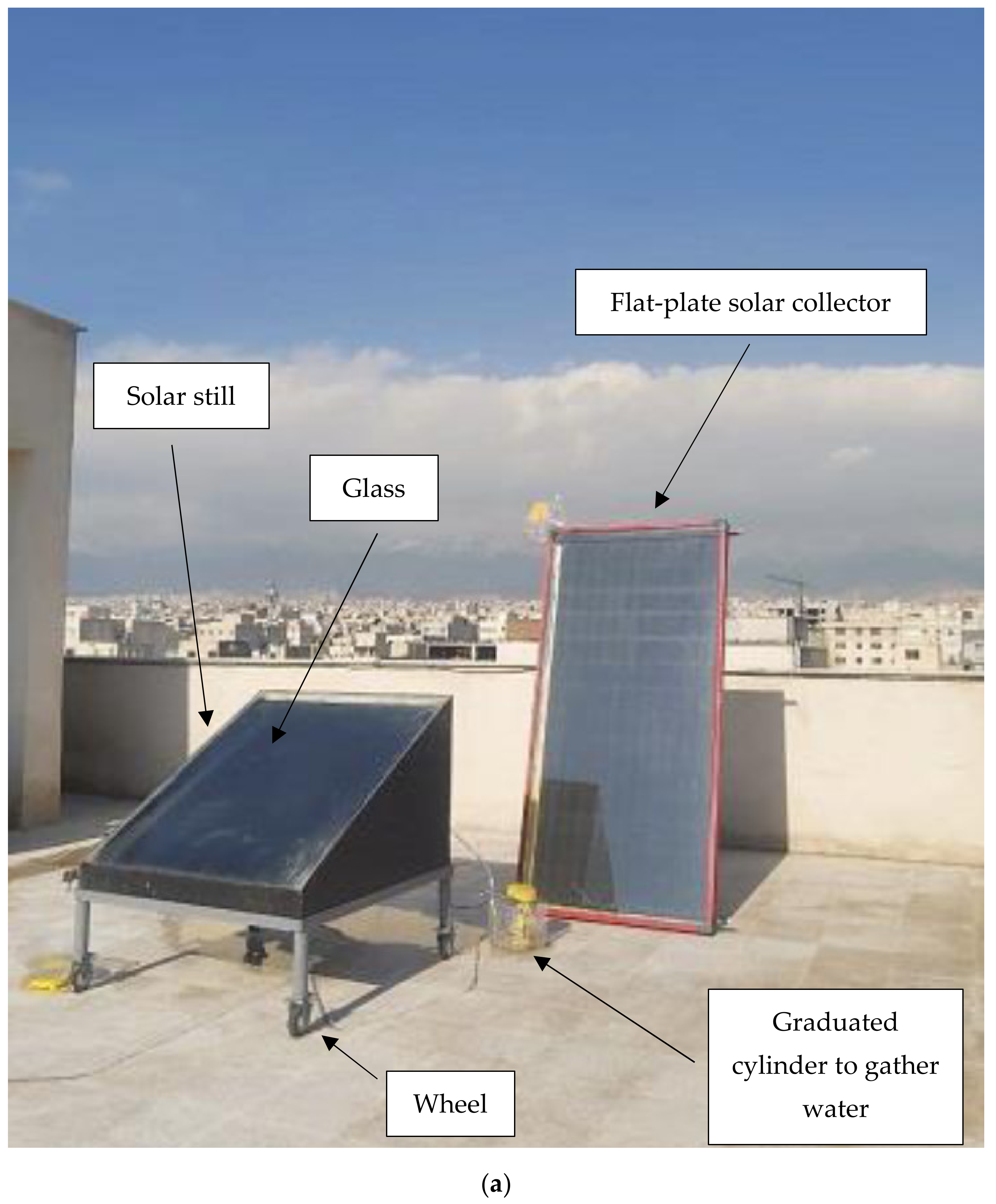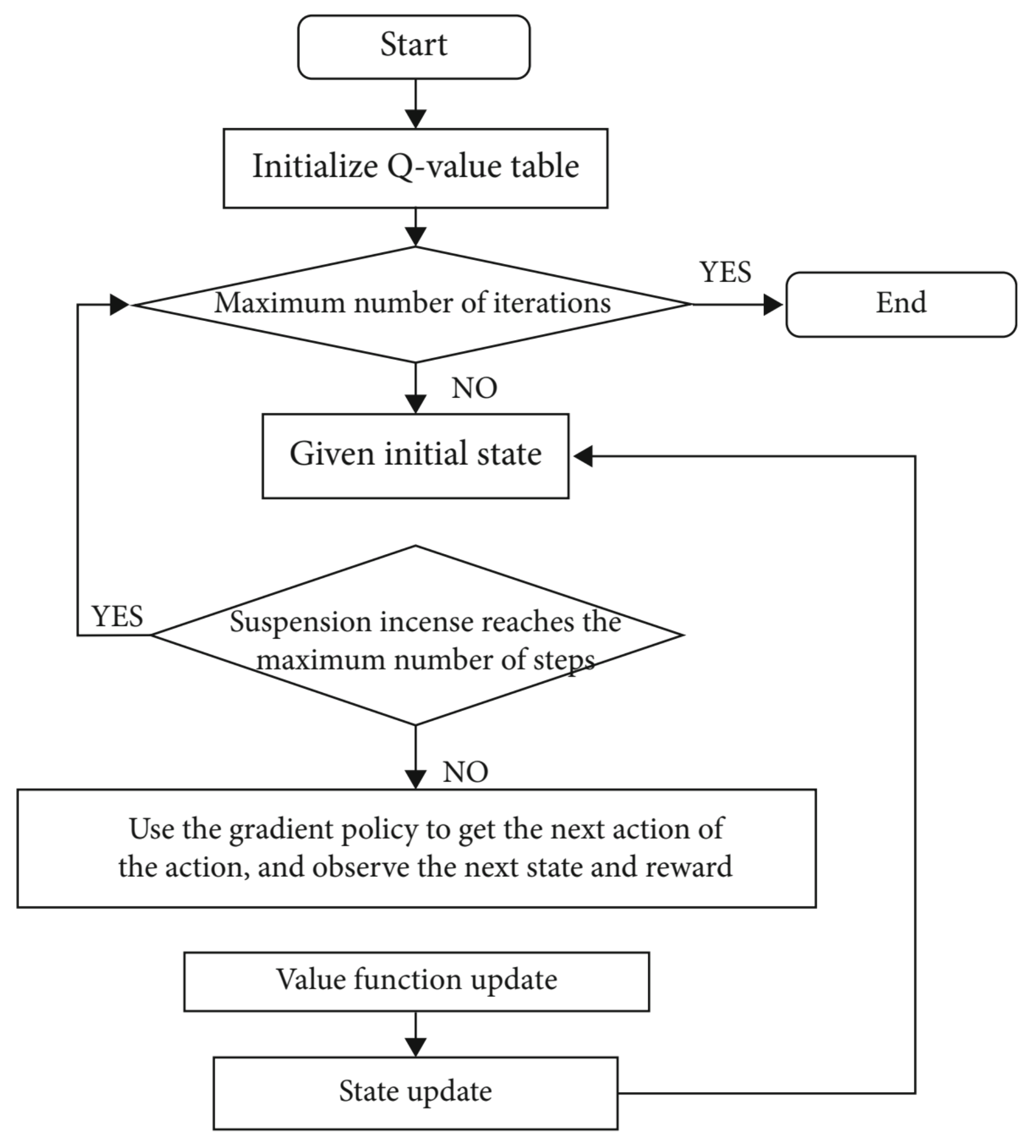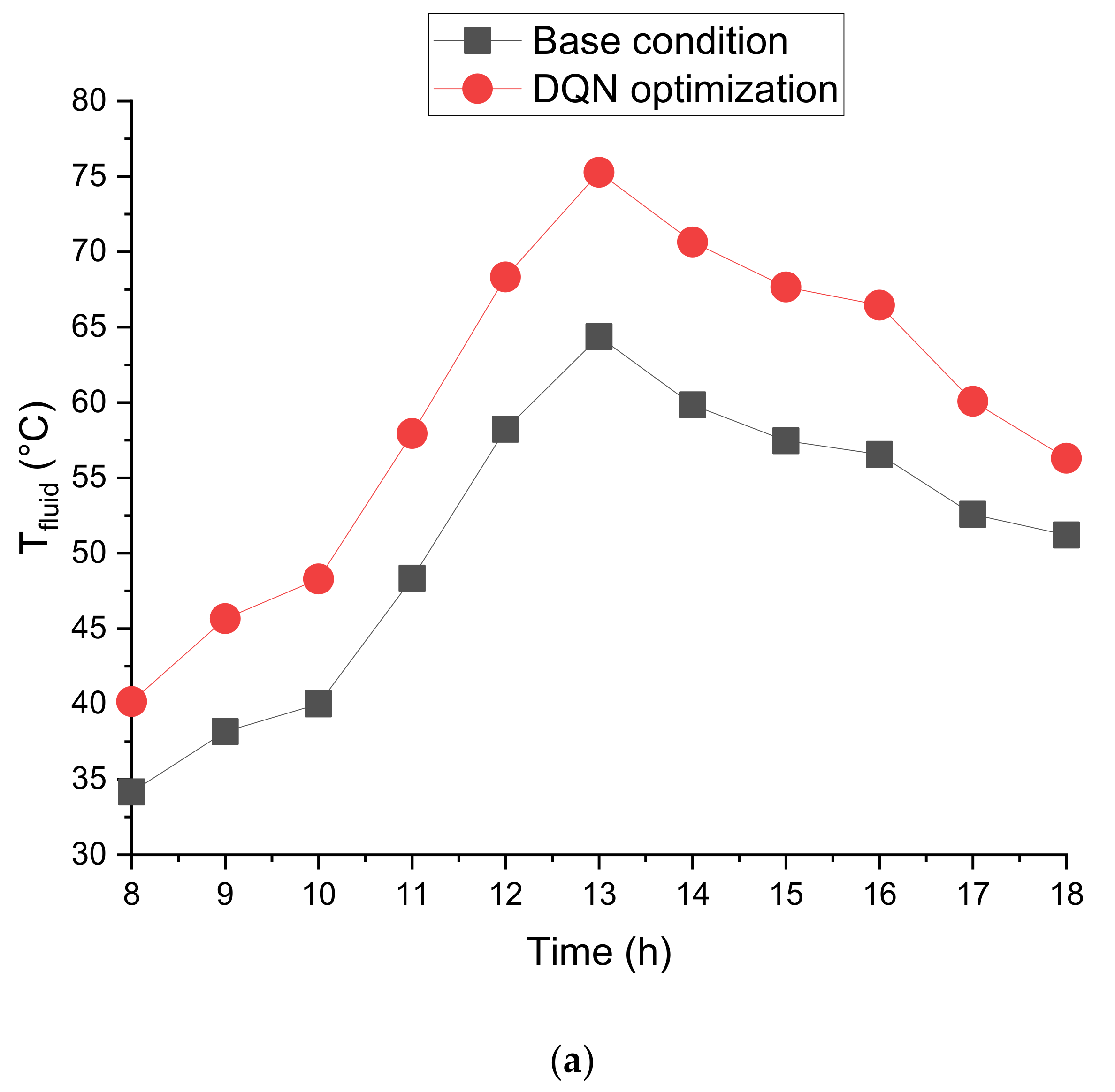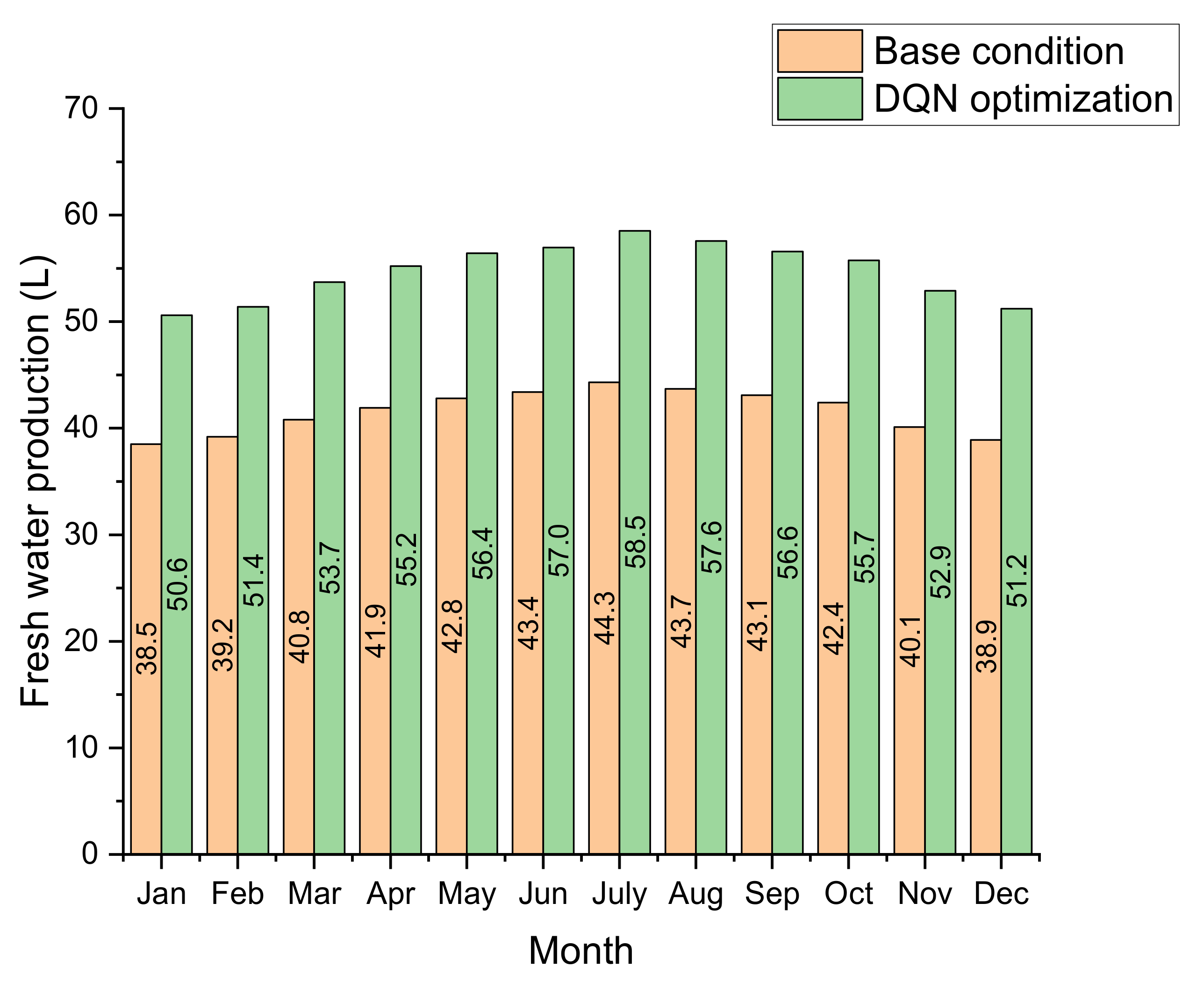Deep Q-Value Neural Network (DQN) Reinforcement Learning for the Techno-Economic Optimization of a Solar-Driven Nanofluid-Assisted Desalination Technology
Abstract
:1. Introduction
2. The Studied Solar-Driven Desalination System
3. Materials and Methods
3.1. Studied Performance Indicators
- Efficiency.
- Cost per liter (CPL).
3.1.1. Efficiency
3.1.2. Cost Per Liter (CPL)
3.2. Uncertainty Analysis
3.3. Optimization Using DQN
4. Results and Discussion
4.1. The Daily Values
4.2. The Values throughout the Year
4.3. Average Relative Uncertainty Values
5. Conclusions and Remarks
Author Contributions
Funding
Institutional Review Board Statement
Informed Consent Statement
Data Availability Statement
Conflicts of Interest
Nomenclature
| Symbols | |
| Arec | The solar radiation receiving area (m2) |
| ARU | Average relative uncertainty |
| C | Cost ($) |
| CPL | Cost per liter ($·L−1) |
| CREF | Cost recovery factor |
| eff | Efficiency |
| f | Fraction |
| h | Enthalpy (kJ·kg−1) |
| i | Inflation |
| G | Solar radiation (W·m−2) |
| m | Mass (kg) |
| N | Number of operation years (yr) |
| PP | Purchase price ($) |
| SFUF | Sinking fund factor |
| T | Temperature (°C or K) |
| V | Volume (m3) |
| Subscripts | |
| fluid | Fluid |
| FWP | Freshwater production |
| OPM | Operating and maintenance |
| PEP | Purchase price |
| SAL | Salvage |
| ST | Solar still |
| Abbreviations | |
| CFWP | Cumulative fresh water production system |
| HFWP | Hourly fresh water production |
| OSTSWNF | The optimized solar still system with nanofluid |
| STSWWA | The solar still system with water |
References
- Sohani, A.; Hoseinzadeh, S.; Berenjkar, K. Experimental analysis of innovative designs for solar still desalination technologies; An in-depth technical and economic assessment. J. Energy Storage 2021, 33, 101862. [Google Scholar] [CrossRef]
- Sharshir, S.W.; Kandeal, A.; Algazzar, A.M.; Eldesoukey, A.; El-Samadony, M.; Hussien, A. 4-E analysis of pyramid solar still augmented with external condenser, evacuated tubes, nanofluid and ultrasonic foggers: A comprehensive study. Process Saf. Environ. Prot. 2022, 164, 408–417. [Google Scholar] [CrossRef]
- Nazari, S.; Najafzadeh, M.; Daghigh, R. Techno-economic estimation of a non-cover box solar still with thermoelectric and antiseptic nanofluid using machine learning models. Appl. Therm. Eng. 2022, 212, 118584. [Google Scholar] [CrossRef]
- Sadeghzadeh, M.; Ghorbani, B.; Ahmadi, M.H.; Sharma, S. A solar-driven plant to produce power, cooling, freshwater, and hot water for an industrial complex. Energy Rep. 2021, 7, 5344–5358. [Google Scholar] [CrossRef]
- Abdelkareem, M.A.; Assad, M.E.H.; Sayed, E.T.; Soudan, B. Recent progress in the use of renewable energy sources to power water desalination plants. Desalination 2018, 435, 97–113. [Google Scholar] [CrossRef]
- Fang, Y.; Memon, S.; Peng, J.; Tyrer, M.; Ming, T. Solar thermal performance of two innovative configurations of air-vacuum layered triple glazed windows. Renew. Energy 2019, 150, 167–175. [Google Scholar] [CrossRef]
- Pourkiaei, S.M.; Ahmadi, M.H.; Ghazvini, M.; Moosavi, S.; Pourfayaz, F.; Kumar, R.; Chen, L. Status of direct and indirect solar desalination methods: Comprehensive review. Eur. Phys. J. Plus 2021, 136, 602. [Google Scholar] [CrossRef]
- Parsa, S.M.; Majidniya, M.; Alawee, W.; Dhahad, H.A.; Ali, H.M.; Afrand, M.; Amidpour, M. Thermodynamic, economic, and sensitivity analysis of salt gradient solar pond (SGSP) integrated with a low-temperature multi effect desalination (MED): Case study, Iran. Sustain. Energy Technol. Assessments 2021, 47, 101478. [Google Scholar] [CrossRef]
- Parsa, S.M.; Momeni, S.; Hemmat, A.; Afrand, M. Effectiveness of solar water disinfection in the era of COVID-19 (SARS-CoV-2) pandemic for contaminated water/wastewater treatment considering UV effect and temperature. J. Water Process Eng. 2021, 43, 102224. [Google Scholar] [CrossRef]
- Parsa, S.M.; Javadi, D.; Rahbar, A.; Majidniya, M.; Aberoumand, S.; Amidpour, Y.; Amidpour, M. Experimental assessment on passive solar distillation system on Mount Tochal at the height of 3964 m: Study at high altitude. Desalination 2019, 466, 77–88. [Google Scholar] [CrossRef]
- Imran, M.; Farooq, U.; Waqas, H.; Anqi, A.E.; Safaei, M.R. Numerical performance of thermal conductivity in Bioconvection flow of cross nanofluid containing swimming microorganisms over a cylinder with melting phenomenon. Case Stud. Therm. Eng. 2021, 26, 101181. [Google Scholar] [CrossRef]
- Mahian, O.; Bellos, E.; Markides, C.N.; Taylor, R.A.; Alagumalai, A.; Yang, L.; Qin, C.; Lee, B.J.; Ahmadi, G.; Safaei, M.R.; et al. Recent advances in using nanofluids in renewable energy systems and the environmental implications of their uptake. Nano Energy 2021, 86, 106069. [Google Scholar] [CrossRef]
- Alazwari, M.; Safaei, M. Combination Effect of Baffle Arrangement and Hybrid Nanofluid on Thermal Performance of a Shell and Tube Heat Exchanger Using 3-D Homogeneous Mixture Model. Mathematics 2021, 9, 881. [Google Scholar] [CrossRef]
- Sadeghzadeh, M.; Maddah, H.; Ahmadi, M.H.; Khadang, A.; Ghazvini, M.; Mosavi, A.; Nabipour, N. Prediction of Thermo-Physical Properties of TiO2-Al2O3/Water Nanoparticles by Using Artificial Neural Network. Nanomaterials 2020, 10, 697. [Google Scholar] [CrossRef] [Green Version]
- Zhang, H.; Yan, S.; Gao, H.; Yuan, X.; Ming, T.; Ahmadi, M.H.; Zhao, X. Experimental investigation and prediction of changes in thermal conductivity of carbon nanotube nanofluid. Int. Commun. Heat Mass Transf. 2021, 127, 105526. [Google Scholar] [CrossRef]
- Beigzadeh, M.; Pourfayaz, F.; Ahmadi, M.H. Modeling and improvement of solid oxide fuel cell-single effect absorption chiller hybrid system by using nanofluids as heat transporters. Appl. Therm. Eng. 2020, 166, 114707. [Google Scholar] [CrossRef]
- Eshgarf, H.; Kalbasi, R.; Maleki, A.; Shadloo, M.S.; Karimipour, A. A review on the properties, preparation, models and stability of hybrid nanofluids to optimize energy consumption. J. Therm. Anal. 2020, 144, 1959–1983. [Google Scholar] [CrossRef]
- Kahani, M.; Ghazvini, M.; Mohseni-Gharyehsafa, B.; Ahmadi, M.H.; Pourfarhang, A.; Shokrgozar, M.; Heris, S.Z. Application of M5 tree regression, MARS, and artificial neural network methods to predict the Nusselt number and output temperature of CuO based nanofluid flows in a car radiator. Int. Commun. Heat Mass Transf. 2020, 116, 104667. [Google Scholar] [CrossRef]
- Maleki, A.; Haghighi, A.; Mahariq, I. Machine learning-based approaches for modeling thermophysical properties of hybrid nanofluids: A comprehensive review. J. Mol. Liq. 2020, 322, 114843. [Google Scholar] [CrossRef]
- Birjandi, A.K.; Shahrestani, M.I.; Maleki, A.; Habibi, A.; Pourfayaz, F. Thermal conductivity estimation of nanofluids with TiO2 nanoparticles by employing artificial neural networks. Int. J. Low-Carbon Technol. 2021, 16, 740–746. [Google Scholar] [CrossRef]
- Sohani, A.; Shahverdian, M.H.; Sayyaadi, H.; Samiezadeh, S.; Doranehgard, M.H.; Nizetic, S.; Karimi, N. Selecting the best nanofluid type for A photovoltaic thermal (PV/T) system based on reliability, efficiency, energy, economic, and environmental criteria. J. Taiwan Inst. Chem. Eng. 2021, 124, 351–358. [Google Scholar] [CrossRef]
- Elango, T.; Kannan, A.; Murugavel, K.K. Performance study on single basin single slope solar still with different water nanofluids. Desalination 2015, 360, 45–51. [Google Scholar] [CrossRef]
- Sharshir, S.; Kandeal, A.; Ismail, M.; Abdelaziz, G.; Kabeel, A.; Yang, N. Augmentation of a pyramid solar still performance using evacuated tubes and nanofluid: Experimental approach. Appl. Therm. Eng. 2019, 160, 113997. [Google Scholar] [CrossRef]
- Rashidi, S.; Bovand, M.; Rahbar, N.; Esfahani, J.A. Steps optimization and productivity enhancement in a nanofluid cascade solar still. Renew. Energy 2018, 118, 536–545. [Google Scholar] [CrossRef]
- Rashidi, S.; Akar, S.; Bovand, M.; Ellahi, R. Volume of fluid model to simulate the nanofluid flow and entropy generation in a single slope solar still. Renew. Energy 2018, 115, 400–410. [Google Scholar] [CrossRef]
- Parsa, S.M.; Rahbar, A.; Koleini, M.; Aberoumand, S.; Afrand, M.; Amidpour, M. A renewable energy-driven thermoelectric-utilized solar still with external condenser loaded by silver/nanofluid for simultaneously water disinfection and desalination. Desalination 2020, 480, 114354. [Google Scholar] [CrossRef]
- Parsa, S.M.; Rahbar, A.; Koleini, M.; Javadi, Y.D.; Afrand, M.; Rostami, S.; Amidpour, M. First approach on nanofluid-based solar still in high altitude for water desalination and solar water disinfection (SODIS). Desalination 2020, 491, 114592. [Google Scholar] [CrossRef]
- Parsa, S.M.; Yazdani, A.; Dhahad, H.; Alawee, W.H.; Hesabi, S.; Norozpour, F.; Javadi, D.; Ali, H.M.; Afrand, M. Effect of Ag, Au, TiO2 metallic/metal oxide nanoparticles in double-slope solar stills via thermodynamic and environmental analysis. J. Clean. Prod. 2021, 311, 127689. [Google Scholar] [CrossRef]
- Sohani, A.; Hoseinzadeh, S.; Samiezadeh, S.; Verhaert, I. Machine learning prediction approach for dynamic performance modeling of an enhanced solar still desalination system. J. Therm. Anal. 2021, 147, 3919–3930. [Google Scholar] [CrossRef]
- Sohani, A.; Delfani, F.; Chimeh, A.F.; Hoseinzadeh, S.; Panchal, H. A conceptual optimum design for a high-efficiency solar-assisted desalination system based on economic, exergy, energy, and environmental (4E) criteria. Sustain. Energy Technol. Assess. 2022, 52, 102053. [Google Scholar] [CrossRef]
- Jafari, S.; Aghel, M.; Sohani, A.; Hoseinzadeh, S. Geographical Preference for Installation of Solar Still Water Desalination Technologies in Iran: An Analytical Hierarchy Process (AHP)-Based Answer. Water 2022, 14, 265. [Google Scholar] [CrossRef]
- Nazari, S.; Safarzadeh, H.; Bahiraei, M. Performance improvement of a single slope solar still by employing thermoelectric cooling channel and copper oxide nanofluid: An experimental study. J. Clean. Prod. 2018, 208, 1041–1052. [Google Scholar] [CrossRef]
- El-Gazar, E.; Zahra, W.; Hassan, H.; Rabia, S.I. Fractional modeling for enhancing the thermal performance of conventional solar still using hybrid nanofluid: Energy and exergy analysis. Desalination 2021, 503, 114847. [Google Scholar] [CrossRef]
- Kabeel, A.; Sharshir, S.W.; Abdelaziz, G.B.; Halim, M.; Swidan, A. Improving performance of tubular solar still by controlling the water depth and cover cooling. J. Clean. Prod. 2019, 233, 848–856. [Google Scholar] [CrossRef]
- Bellila, A.; Attia, M.E.H.; Kabeel, A.E.; Abdelgaied, M.; Harby, K.; Soli, J. Productivity enhancement of hemispherical solar still using Al2O3-water-based nanofluid and cooling the glass cover. Appl. Nanosci. 2021, 11, 1127–1139. [Google Scholar] [CrossRef]
- Panchal, H.; Sadasivuni, K.K.; Suresh, M.; Yadav, S.; Brahmbhatt, S. Performance analysis of evacuated tubes coupled solar still with double basin solar still and solid fins. Int. J. Ambient. Energy 2018, 41, 1031–1037. [Google Scholar] [CrossRef]
- Kabeel, A.; Sathyamurthy, R.; Manokar, A.M.; Sharshir, S.W.; Essa, F.; Elshiekh, A.H. Experimental study on tubular solar still using Graphene Oxide Nano particles in Phase Change Material (NPCM’s) for fresh water production. J. Energy Storage 2020, 28, 101204. [Google Scholar] [CrossRef]
- Koç, Y.; Yağlı, H.; Görgülü, A.; Koç, A. Analysing the performance, fuel cost and emission parameters of the 50 MW simple and recuperative gas turbine cycles using natural gas and hydrogen as fuel. Int. J. Hydrogen Energy 2020, 45, 22138–22147. [Google Scholar] [CrossRef]
- Koç, Y.; Yağlı, H.; Kalay, I. Energy, exergy, and parametric analysis of simple and recuperative organic Rankine cycles using a gas turbine-based combined cycle. J. Energy Eng. 2020, 146, 04020041. [Google Scholar] [CrossRef]
- Kabeel, A.; El-Maghlany, W.M.; Abdelgaied, M.; Abdel-Aziz, M.M. Performance enhancement of pyramid-shaped solar stills using hollow circular fins and phase change materials. J. Energy Storage 2020, 31, 101610. [Google Scholar] [CrossRef]
- Appadurai, M.; Raj, E.F.I.; Jenish, I. Application of Aluminium Oxide-Water Nanofluids to Augment the Performance of Shallow Pond: A Numerical Study. Process Integr. Optim. Sustain. 2021, 6, 211–222. [Google Scholar] [CrossRef]
- Shoeibi, S. Numerical Analysis of Optimizing a Heat Sink and Nanofluid Concentration Used in a Thermoelectric Solar Still: An Economic and Environmental Study. Environ. Res. Eng. Manag. 2021, 77, 110–122. [Google Scholar] [CrossRef]
- Shoeibi, S.; Ali Agha Mirjalily, S.; Kargarsharifabad, H.; Panchal, H.; Dhivagar, R. Comparative Study of Double-Slope Solar Still, Hemispherical Solar Still, and Tubular Solar Still using Al2O3/Water Film Cooling: A Numerical Study and CO2 Mitigation Analysis. Environ. Sci. Pollut. Res. 2022, 1–17. [Google Scholar] [CrossRef]
- Zhang, H.; Xu, J.; Qiu, J. An Automatic Driving Control Method Based on Deep Deterministic Policy Gradient. Wirel. Commun. Mob. Comput. 2022, 2022, 7739440. [Google Scholar] [CrossRef]













| Performance Indicator | Device | Uncertainty | Working Range | Unit |
|---|---|---|---|---|
| Irradiance | Solar power meter | 10.0 | 0.0–2000.0 | W·m−2 |
| Wind velocity | Wind meter | 0.2 | 0.0–10.0 | m·s−1 |
| Temperature of water in basin | Thermocouple (K-type) | 0.6 | 0.0–1000.0 | °C |
| Ambient temperature | Ambient thermometer | 0.1 | 0.0–80.0 | °C |
| Fresh water production | Graduated cylinder | 5.0 | 0.0–2000.0 | mL |
| Hour | Ambient Air Temperature (°C) | Solar Radiation (W·m−2) | Wind Velocity (m·s−1) | |||
|---|---|---|---|---|---|---|
| 18 September 2019 | 9 September 2020 | 18 September 2019 | 9 September 2020 | 18 September 2019 | 9 September 2020 | |
| 8 | 18 | 19 | 266.8 | 268.7 | 1.1 | 1.2 |
| 9 | 20 | 20 | 441.8 | 441.6 | 2.2 | 2.3 |
| 10 | 23 | 22 | 610.4 | 612.6 | 1.5 | 1.4 |
| 11 | 24 | 24 | 739.4 | 741.2 | 1.4 | 1.3 |
| 12 | 25 | 25 | 809.6 | 810.3 | 1.6 | 1.6 |
| 13 | 26 | 27 | 812.0 | 814.1 | 1.3 | 1.0 |
| 14 | 27 | 28 | 742.2 | 744.0 | 1.1 | 1.2 |
| 15 | 28 | 29 | 612.7 | 612.9 | 0.9 | 0.8 |
| 16 | 29 | 30 | 449.2 | 451.3 | 1.0 | 0.9 |
| 17 | 28 | 28 | 271.7 | 273.3 | 2.0 | 1.8 |
| 18 | 28 | 27 | 263.4 | 261.9 | 2.6 | 2.5 |
| Parameter | Unit | Value |
|---|---|---|
| percent | 5 | |
| years | 15 | |
| percent | 15 | |
| percent | 20 |
| Performance Indicator | ARU |
|---|---|
| Irradiance | 0.041 |
| Wind velocity | 0.046 |
| Temperature of water in basin | 0.352 |
| Ambient temperature | 0.917 |
| Fresh water production | 1.408 |
Publisher’s Note: MDPI stays neutral with regard to jurisdictional claims in published maps and institutional affiliations. |
© 2022 by the authors. Licensee MDPI, Basel, Switzerland. This article is an open access article distributed under the terms and conditions of the Creative Commons Attribution (CC BY) license (https://creativecommons.org/licenses/by/4.0/).
Share and Cite
Jafari, S.; Hoseinzadeh, S.; Sohani, A. Deep Q-Value Neural Network (DQN) Reinforcement Learning for the Techno-Economic Optimization of a Solar-Driven Nanofluid-Assisted Desalination Technology. Water 2022, 14, 2254. https://doi.org/10.3390/w14142254
Jafari S, Hoseinzadeh S, Sohani A. Deep Q-Value Neural Network (DQN) Reinforcement Learning for the Techno-Economic Optimization of a Solar-Driven Nanofluid-Assisted Desalination Technology. Water. 2022; 14(14):2254. https://doi.org/10.3390/w14142254
Chicago/Turabian StyleJafari, Sina, Siamak Hoseinzadeh, and Ali Sohani. 2022. "Deep Q-Value Neural Network (DQN) Reinforcement Learning for the Techno-Economic Optimization of a Solar-Driven Nanofluid-Assisted Desalination Technology" Water 14, no. 14: 2254. https://doi.org/10.3390/w14142254







